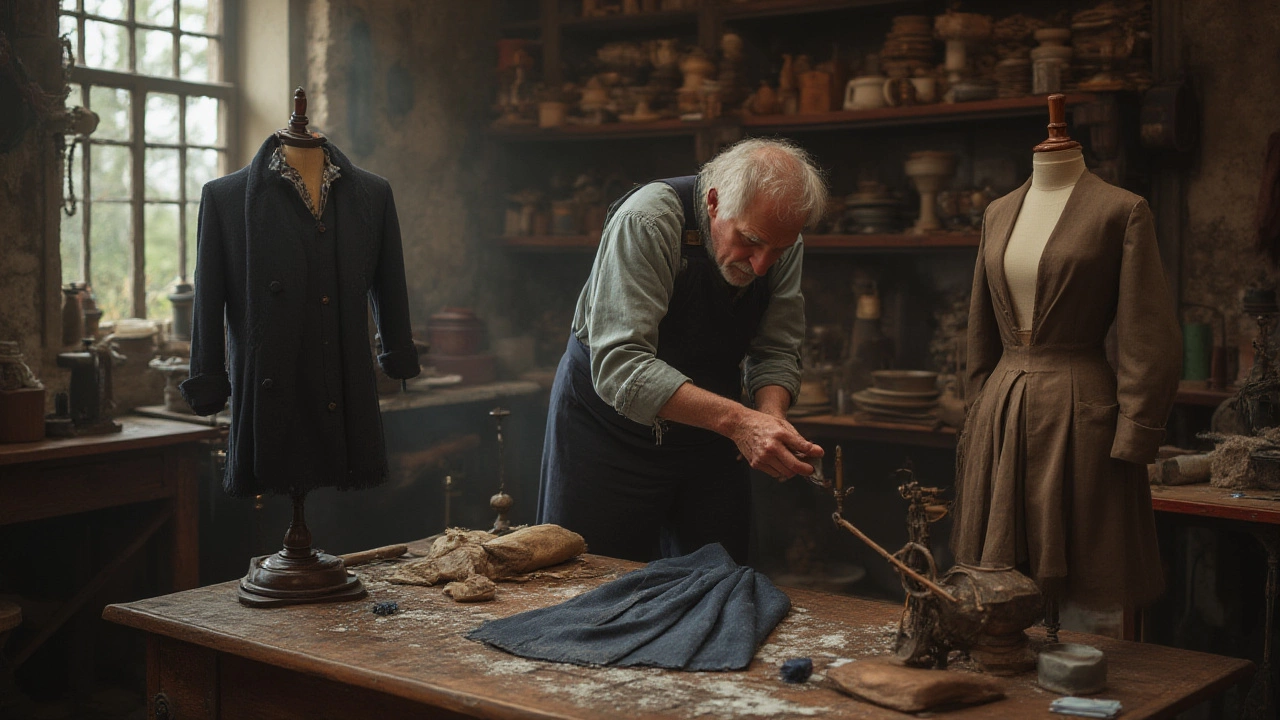Walk down Grafton Street or duck into Brown Thomas in Dublin, and you’ll spot every variety of suit possible. Here in Ireland, suits are much more than just an office staple or wedding attire—they carry signals about status, taste, and locality. But would anyone truly notice if you swapped your €500 suit from a high-street shop for a €5000 bespoke creation from a Savile Row-trained tailor in Cork? Let’s lift the lid on what separates these two price tags in the Irish market and see whether the hype (and cost) are worth it.
Fabric: The Real Foundation of Your Suit
Start by touching the fabric in a men’s department along St. Stephen’s Green. Most €500 suits available on the Irish high street—think Next, Moss Bros, Marks & Spencer or even Paddy Campbell’s in Galway—are often made from blended materials. You’ll see wool-polyester or viscose mixes that give the suit that slightly shiny, less-breathable feel. There’s nothing wrong with stepping into an off-the-rack wool blend, especially given the Irish weather’s unpredictability, but durability and comfort sometimes suffer.
Jump up to a €5000 price bracket, and suddenly you’re handling pure, superfine Merino from Italian mills like Loro Piana or Scabal. Some Irish tailors even source tweed from Donegal or cashmere from Kerry for those who want to nod to our own heritage. The texture's richer, the fabric softer, and crucially, it hangs with far more elegance. High-end suits are naturally breathable—so you’ll be grateful for that when sprinting down Abbey Street in a summer shower or enduring those rare but sticky days at an Irish wedding.
Another big difference is longevity. Premium wool or cashmere simply lasts longer, and with proper care, can even be passed down a generation. Meanwhile, lower-cost blends start to lose their shape after a handful of dry cleans. Ask any old-school Cork tailor, and they'll tell you how the best fabric will drape across the body, rather than cling awkwardly or bunch up at the joints.
If you’re looking for visual proof, hold a €500 suit beside a €5000 one and look at the way the light plays off them in natural Irish daylight. Cheap blends tend to lose their vibrancy and collect unsightly pilling over time, while luxury fabrics “age gracefully” and develop a character of their own, much like a session musician in a Temple Bar pub.
Fit & Finish: Tailoring Makes or Breaks the Look
Here’s where Irish gents often trip up. Walk into a department store in Limerick or Sligo, and you’ll likely be offered off-the-rack sizes. They’re made to fit the average man, but honestly, who’s really average? Our bodies and postures are all over the place—especially after a few pints or rugby matches.
High street tailors will pin and hem a trouser leg or take in a jacket waist, but there are limits. Mass-produced suits are stitched with glue, fused linings, and “one shape fits all” templates. The quickest way to spot it? Look at the shoulders—they’re often boxy and stiff, while the chest and arms balloon uncomfortably. If you’re sitting through a long day in the IFSC or dashing between bus stops on Dawson Street, you’ll feel every cheap seam by tea time.
By contrast, a €5000 Irish-made bespoke suit begins with a basting fitting. In workshops like Louis Copeland & Sons, Magee 1866, or Anthony O’Malley in Dublin, you’ll stand for precise measurements—taking account of sleeve pitch, posture, even natural quirks like a high shoulder or sloping neck. The tailor cuts a suit pattern just for you, using traditional hand-stitching and floating canvassing for a jacket that flexes and shapes to your body over time. This is the pure joy of a real bespoke suit: it feels like slipping on your own skin, but smarter. Even after a long day at a Galway wedding or a networking event at the Convention Centre, you won’t be itching for pyjamas.
Hand-finished touches—like pick-stitching, soft roped shoulders, real buttonholes, finer seams—are not just for bragging rights. These details mean the garment adapts to your movement and lasts longer. If you ever have the chance, pop into a tailor’s fitting room and inspect the inside lining or the collar. Professional Irish tailors obsess over these invisible details. They know word travels fast, whether it’s gossip in Clonakilty or reviews on Boards.ie.

Style, Branding, and Local Trends: Does the Label Really Matter?
Some lads still think it’s all about the label. Sure, fancy names like Hugo Boss, Armani, or Paul Smith can impress the untrained eye. But in Ireland, it’s less about the logo and more about knowing you look the part at a wedding in Ashford Castle or a job interview in central Dublin.
For €500, you’ll get a good-looking suit that photographs well for a graduation picture or a day at the races in Leopardstown. The cuts follow basic trends—skinny, slim, or classic. Accessories like cheap plastic buttons or generic stitching keep the cost down. You’ll blend in well with most crowds from Cork to Derry. Plus, if you spill a Smithwick’s down your lap at the pub, you won’t lose sleep.
Step into bespoke or luxury territory, though, and the vibe changes. High-end Irish tailors cater for the subtle differences in local tastes: a sharply defined three-piece for a barrister at the Four Courts; a tweed with character for a Trinity graduate; a big, bold windowpane check for a Donegal wedding. The choices are endless—lapel width, trouser break, vent style, lining pattern, monograms. These details tell your story before you even shake hands. Irish designers like Peter O’Brien or international brands stocked in Brown Thomas frequently offer collaborations with local artisans—so even a luxury suit has a uniquely Irish twist.
And if you’re aiming to stand out, remember: few things are more telling than a confident fit. Irish streets are full of men who paid through the nose but never went for a proper fitting—or wore a designer suit with the sleeves still tacked shut. Don’t hide behind the logo; flaunt the drama of a suit that genuinely fits your frame and personality.
Practical Tips: When Is It Worth the Upgrade?
So, is a €5000 suit always the right call? Not really. Most Irish lads need only a handful of suits in their lifetime—perhaps one for big job interviews, another for weddings, and one for funeral or formal events. High-street stores in Dublin, Cork, or Limerick do a roaring trade in €500 suits for just these moments. Local alteration services—even pop-up tailors in Rathmines or Galway—can transform a standard suit into something genuinely sharp for not much cash.
Here’s a quick guide for Irish shoppers considering their next suit investment:
- Budget suits (under €500): Great for occasional wear—graduations, a single event, or a backup. But don’t expect them to survive years of daily use.
- Mid-range suits (€500–€1500): Suits from well-known brands, Irish labels like Magee, or higher-end department stores offer better wool mixes, some half-canvas construction, and a bit more tailoring. Perfect for a regular office goer or a stylish best man.
- Luxury bespoke (over €3000): Hand-cut, measured, made over weeks or even months. An investment piece to be worn at life’s major moments—think winner’s circle at Punchestown, big presentations, or family occasions where you want to feel truly yourself.
If you’re spending big, pick a timeless style—navy, charcoal, or a deep Irish green will get the most wear. Stick to natural fibres for breathability, and get measured by a reputable Irish tailor at least once in your life. For anyone living or working here, it’s worth paying a visit to trusted names like Louis Copeland or Magee for advice, or even dropping into The Master Tailor on South William Street for an honest opinion. They won’t upsell you for the sake of it—they want Irish men to look well, after all.
And don’t forget maintenance: proper hangers, regular brushing, and the occasional press will keep even a modest suit looking sharp for years. If you’re ever curious how the upper crust keep their suits in shape, check with Dublin’s “Celtic Tiger” generation—they swear by professional pressing and careful storage in cedar wardrobes.
| Suit Price Range | Features | Typical Lifespan |
|---|---|---|
| Up to €500 | Synthetic blends, off-the-rack fit, machine-made, fused construction | 1-2 years (occasional wear) |
| €500–€1,500 | Wool blends, better fit, some half-canvas, simple customisation | 3-6 years (frequent wear) |
| €3,000+ | Pure wool/cashmere/tweed, bespoke fit, hand-finished, floating canvas | 10-20 years (with care) |
So, next time you spot someone strolling down Dawson Street in a suit that actually moves with them—no awkward bunching, no plasticky sheen—just know the hidden story: Irish tailoring has always been about more than showing off. It’s the quiet pride in details, the celebration of heritage, and the feeling you get when you stand a little taller. When you weigh up your own decision, remember, in Ireland’s climate and culture, a suit isn’t just what you wear—it’s how you show up for life’s big moments.
